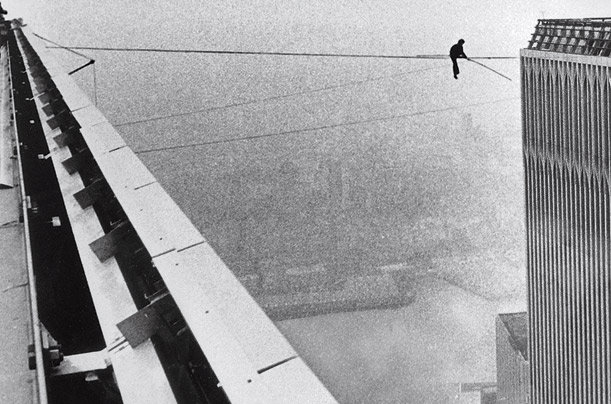On a cold, windless New York morning in August 1974, French street performer Philippe Petit stepped onto a tightrope and into history books. The rope was stretched between the twin towers of the World Trade Centre, over one thousand feet in the sky. He spent over forty-five minutes on the wire, without a security harness or any form of support, taunting the police officers sent to arrest him, while stunned commuters gazed up at him from below. One passer-by later referred to him as a 'highwire dancer', because 'walker' simply would not do his flamboyance and confidence justice. Philippe himself stated that he 'wrote with his body in the sky'.
Their amazement will come as no surprise to anyone who has seen pictures of his walk – from a distance the wire becomes almost invisible, as if he is walking on air. Even without this illusion, the image is still jaw-dropping, and immediately iconic.
Born in 1949 in Nemours, France, he was less than a
conformist, getting himself expelled from several schools before dropping out
altogether. It took him only a year to train himself to wire walk, doing tricks
like back flips, jumping trough hoops and using a unicycle, and became an
established street performer, and pick pocket, on the streets of Paris. While plying
his trade on a slack wire in Washington Square Park in New York, he came up
with the idea of taking his performance to the next level - traversing the sky
over famous landmarks across the globe. It was in the early seventies that
these walks took place – firstly between the towers of the Notre Dame Cathedral,
and then between the pylons of the Sydney Harbour Bridge. After being
apprehended by the Australian authorities, he pick-pocketed the arresting
officer, and stole his watch. As impressive as these daredevil feats were, they
were only the stepping stones to the walk that would make him famous.
Petit had spent most of his life waiting for his chance to
walk between the towers, ever since he saw a newspaper article about its
construction as a teenager while living in Paris. In interviews he has
constantly spoke of the event as if it is fate, like two lovers destined to meet
–
‘didn't choose it. It chose me. So here I am - a prisoner of something I love.'Later, he discussed the operation - planned over the course of six years - as a bank job, a heist, and with all the meticulous research and preparation that it involved. He employed 'inside men', and referred to it as a coup. This reflects an interesting mindset of Petit - his idea of himself as a roguish criminal. He used to pick pockets, and when he met the director James Marsh, when the two collaborated on Oscar-winning documentary Man On Wire, Marsh noted that Petit explained how he could kill a man with a copy of People magazine, and then proceeded to rob him.
Petit has, since that day, became a more enigmatic film. He still walks occasionally, such as over the Niagra Falls in 1986, a recreation of Charles Blondin's stunt. The most he has come into the spotlight was after the release of Man On Wire, where he discussed the planning and executing of his coup. He largely dodges the question that he gets the most - why? His stunt, his art, propelled him into that category of performers and artists who are asked constantly why they did what they did. Bill Drummond and Jimmy Caulty will forever be asked why they burnt a million quid. Petit will always be asked why. He once answered
'I see three oranges, I juggle. I see two towers, I walk.'


No comments:
Post a Comment